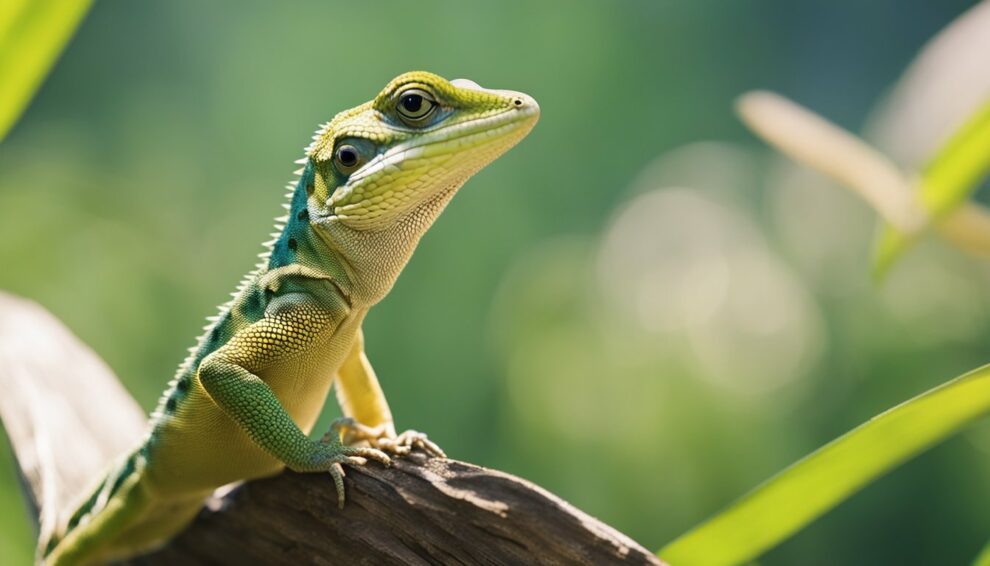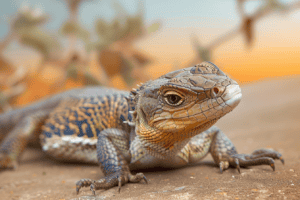Imagine a creature that can glide effortlessly through the trees, using wings that aren’t really wings at all.
Meet the flying lizards, also known as “draco” lizards, whose gliding feats are nothing short of extraordinary.
These scaly aviators have captured human fascination with their unique adaptation that allows them to soar between the trees of the Southeast Asian forests they call home.

The flying lizard’s ability to glide is not just for show; it serves key survival functions.
By extending a flap of skin on either side of their bodies, these lizards can escape predators, travel to find food, or even interact in social activities.
Isn’t it amazing how a bit of skin stretched out can turn into such a useful gliding tool?
They may not have the size or majesty of mythical dragons, but they’ve certainly got the moves that would make any creature envious.
Now, how do they execute these aerial acrobatics?
The process is surprisingly efficient: a flying lizard will climb to a high point, leap off, and extend its patagium—a membrane supported by elongated ribs.
Acting like a parachute or a hang glider, this membrane catches the air, carrying the lizard to its next stop.
These lizards can glide up to 60 feet, a remarkable feat for a creature no longer than a pencil!
And it’s not just a random float down; flying lizards can navigate mid-air, allowing them to select the perfect landing spot.
Can you imagine journeying from tree to tree without ever touching the ground?
The Marvel of Gliding Lizards

Gliding lizards are remarkable for their aerial abilities, taking to the skies with an anatomy tailored for flight and an evolutionary history that’s as intriguing as it is unique.
Anatomy of Flight
These lizards have developed patagia, which are wing-like flaps of skin that stretch between their ribs.
When they leap from tree to tree, their ribs extend, creating a surface area that supports their body in the air, much like a parachute.
The tail acts as a rudder, guiding the lizard’s direction with precision, while the limbs are used to adjust altitude and navigate during the glide.
Evolutionary Wonders
It’s enthralling to think about how a creature that once roamed the earth’s surface evolved to master the air above.
Over millions of years, gliding lizards have adapted to their environment by developing these extended ribs and skin flaps.
This adaptation was likely a response to the need to escape predators, reach new territories, and exploit the rich resources in the treetops.
The ability to glide from tree to tree gave them an edge in survival and reproduction.
The perfection of this trait across different species of gliding lizards supports the idea that it is a successful evolutionary strategy.
Have you ever wondered what it would be like to soar through the treetops?
Picture the gliding lizard launching itself, catching the breeze, and landing gracefully on a distant branch—she’s not just moving through her habitat; she’s a part of the wind itself.
Isn’t nature incredible?
Ecology and Habitat

Flying lizards have mastered the art of tree-top living and have a unique way of escaping danger—by gliding gracefully through the air.
Their homes and daily routines are just as intriguing as their aerial acrobatics.
Home Among the Trees
These scaly aviators spend a great deal of their lives in the lush, green canopies of tropical rainforests in Southeast Asia.
They are arboreal, which means they really love hanging out in trees.
Their habitats are carefully nestled high above the ground, amidst dense foliage that offers both food and protection.
The dense leaf coverage is crucial for these creatures to leap and glide from tree to tree with the greatest of ease.
Diet and Predators
What do these lizards munch on up there?
They are insectivores, with a diet primarily consisting of ants, termites, and small beetles, which they expertly snatch up with their quick reflexes and sharp eyesight.
The sticky pads on their toes allow them to scale smooth surfaces and capture their prey with remarkable efficiency.
However, life in the trees comes with its own set of challenges.
These lizards are often on the lookout for birds of prey and larger reptiles—sneaky predators that wouldn’t mind a lizard for lunch.
To evade these threats, flying lizards will spread their rib-supported patagia (think of them as built-in wing suits) and glide to a neighboring tree, effectively dodging danger with a thrilling aerial escape.
Conservation Status

Understanding the conservation status of flying lizards is crucial to ensuring these fascinating animals continue to soar through their forest homes.
What challenges do they face, and how do human activities add to their plight?
Environmental Threats
Flying lizards are sensitive to the health of their habitats—tropical forests in Southeast Asia.
Deforestation due to logging and agricultural expansion poses a significant threat to these species.
The loss of trees not only takes away their natural “launching pads” and “landing zones,” but also affects the delicate balance within these ecosystems.
Human Impact
Humans have a profound impact on the existence of flying lizards. The pet trade has led to many of these creatures being taken from the wild.
Though some species are not yet on the brink of extinction, they could slide towards endangered status if human pressures are not reduced.
Forests are shrinking, and with each tree that falls, a piece of a flying lizard’s territory disappears.
Would you believe that protecting forests can also help these extraordinary lizards glide from tree to tree without a worry?
Every action to preserve their environment matters, be it big or small.
Indeed, ensuring the survival of flying lizards is an admirable goal that requires understanding, compassion, and most importantly, action from all of us.
Frequently Asked Questions

Curiosity piques as we explore the aerial abilities of the draco lizard, a marvel in the realm of gliding reptiles.
This section will answer several intriguing questions about these sky-surfing lizards.
How can some lizards glide through the air?
Some lizards, notably the draco species, possess a unique structure called the patagium, an extendable membrane that stretches between their ribs.
When they leap off of heights, they spread their ribs outward, pulling this wing-like membrane taut, which catches the air and allows them to glide gracefully from one location to another.
What special features help draco lizards glide from tree to tree?
Draco lizards are equipped with elongated ribs and a patagium that enable their amazing gliding feats.
Their small, flattened bodies reduce air resistance, and a flap of skin on their throat called the gular flap helps to stabilize flight.
They can maneuver in midair masterfully, altering their flight path to safely reach their desired perch.
How does the draco lizard’s ability to fly help it survive?
Gliding empowers draco lizards to escape predators with a swift, airborne retreat.
This ability also enhances their hunting strategy, allowing them to swoop down on unsuspecting insects.
Additionally, gliding is a quick method of transportation to explore new territories, which is essential for finding food and mates without having to descend to the predator-filled forest floor.
What environments are flying lizards typically found in?
These remarkable lizards are usually found in the dense tropical forests of Southeast Asia.
Their gliding capabilities are best suited for the high trees of this environment, where they spend most of their time lounging and leaping between the canopy’s vast network of branches and leaves.
Can you have a draco lizard as a pet, and what care do they require?
While it is not commonplace, some people do keep draco lizards as pets.
They require a large terrarium with ample vertical space to mimic their natural arboreal habitat.
The environment should have high humidity and plenty of climbing structures.
Special attention must be given to their dietary and lighting needs to keep them healthy and thriving.
What are the differences between flying lizards and other gliding animals?
Differing from other gliders like flying squirrels or sugar gliders, draco lizards glide using their extended ribs and a specialized membrane, while mammals use a membrane that stretches between limbs.
Additionally, flying lizards are reptiles, hence they are cold-blooded and have scales, contrasting with the warm-blooded, fur-covered mammalian gliders.
Each type of gliding animal has adapted to their specific environment in unique ways to benefit their survival and mobility.









